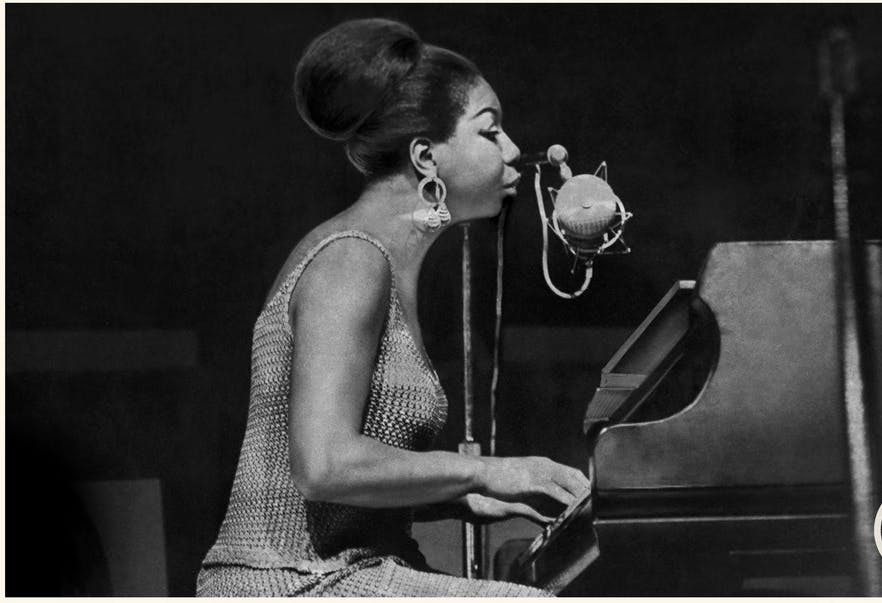Capturing a Piece of the Transformative Nina Simone
A previously unreleased concert recording from the Newport Jazz Festival in 1966 is only six songs and 32 minutes, but is quite perfect for that.

Nina Simone
‘You’ve Got To Learn’
Verve Records
The art of Nina Simone is the art of transformation. This becomes abundantly clear on “You’ve Got To Learn,” a previously unreleased concert recording from the Newport Jazz Festival in 1966.
Ken Druker, who produced the new album (available digitally and on CD and vinyl), wisely titled it after the first song. With lines like “You’ve got to learn although it’s very hard / The way of pocketing your pride / Sometimes face humiliation / While you were burning up inside,” Simone makes the song sound like it’s about an African-American woman passing life lessons to a child — lessons, unfortunately, about generations of prejudice and bigotry. The song, though, was written by a great French composer-singer, Charles Aznavour, who was, in all likelihood, thinking about something else entirely.
By the end of “You’ve Got to Learn,” Simone has made it clear it doesn’t matter what’s causing the pain that she’s trying to ameliorate. She slowly raises her voice, slows down to almost a standstill, and builds to what can only be called a musical climax of sheer empathy: “You’ve got to learn from hard experience / And listen to advice / And sometimes pay the price / And learn to live with a broken heart.” It’s a devastating enough moment to have concluded the concert right then and there.
“And now we’re going to do a gutbucket blues,” Simone announces a few songs later. “It is so because of its background. There’s an old porch, and there’s an old man, and there’s a beat-up guitar and a broken bottle. There are flies all around, there is molasses all around, and he is composing this tune on a hot afternoon. The lyrics are written by Abbey Lincoln, and I wrote the music. It will appeal to a certain type of woman who’ve had this kind of experience.”
“Blues For Mama,” which she famously recorded a few months later on “Nina Simone Sings the Blues,” is also driven by apparent contradictions. She paints a picture of a typical male country blues singer, and yet the song is, from the title onward, clearly for and about a woman. Jazz singer Lincoln was already growing into one of the greatest writers of songs in the jazz idiom, yet both the music and lyrics here are composed of the most basic blues material, including an extended stop-time break sequence. Simone begins by pounding on a single piano note, as if trying to twist it out of tune. She then proceeds to take this exceedingly simple concoction and milk it for everything it’s worth, to extract more feeling than you might imagine it could possibly support.
“Be My Husband,” which Simone had introduced on her 1965 studio album “Pastel Blue,” herewith becomes a consummate performance art piece for live concerts. It’s a largely a capella set of chants and handclaps, for which she’s joined by the rest of her trio, guitarist Rudy Stevenson, bassist Lisle Atkinson, and drummer Bobby Hamilton.
It’s widely acknowledged that Simone inspired the hit version of “Don’t Let Me Be Misunderstood” by a British invasion band, The Animals. It seems no less obvious that “Be My Husband” is the direct antecedent of “We Will Rock You,” the very similar a capella chanting-and-handclapping concert performance art piece by Queen.
Sometimes the transformative process extends to Simone’s own work. “Mississippi Goddam” was the artist’s most aggressive protest song, which she originally and rather subversively cast in the mold of a bouncy Jerry Herman-style show tune in 2/4. This concert version is an altogether different conception; now, it’s more of a bluesy, R&B-style riff, almost like something Louis Jordan might have played. She also starts this one lightly and buoyantly, but it grows more intense over the course of nearly seven minutes.
At the end of “Mississippi Goddam,” she announces “that’s it,” but then she returns with a very surprising encore; after that loud and aggressive anthem, she delivers one of the most tender love songs in her canon. This is “Music For Lovers,” rendered even more movingly here than in her two later studio recordings, on the 1968 album “Nina Simone on Piano” and then the 1978 “Baltimore.” “Music For Lovers,” by the composer of “Fly Me to the Moon,” Bart Howard, otherwise best known as accompanist to cabaret and supper club doyenne Mabel Mercer, shows that Simone stayed in touch with that world as well. In less than a heartbeat, she goes from being fiercely confrontational to intimately compassionate.
The concert is only six songs — also including a ravishing reading of one of her early hits, “I Loves You Porgy” — and 32 minutes, but is quite perfect for that. She’s already given us music for protesters and music for marchers; how better to end, then, than with music for lovers?

